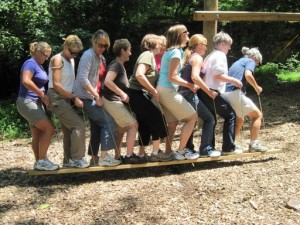
Just as every person is different, every group, every team is also different. The team building program must change along with the team.
Challenge courses, also known as adventure or ropes courses, have been around since 1941. They started as a military tool to train soldiers and foster a sense of teamwork in a relatively short period of time. Today, these fun and educational courses have become a popular tool for the private sector as well. Many organizations swear by these courses as a means to positively affect not only teamwork, but also leadership, communication, productivity, and so much more.
“In the same way that naturally occurring events create changes for an organization, an organization has the ability to create a team building event that contributes to a culture of dynamic leaders who naturally adapt and respond to change,” writes author Katherine T. Whitnah.2 “As a result, organizations attain their goal of an inspired climate of learning that delivers ongoing and possibly accelerated, leadership development for individuals, teams, and the organization as a whole.”
However, what may work from Group A may not work as well for Group B. Just look at the wide range of “teams” that typically utilize such adventure courses. What may be appropriate for a college soccer team to learn to work together is probably not going to work quite as well for a group of businessmen and women trying to improve office communication. The team building program must change along with the team.
People are unique. And just as every person is different, every group, every team is also different. So, every ropes course experience must also be slightly different – customized for each specific group.3 While a low or high ropes course may not change, how one utilizes it should. Providing the same activity to different people, under different circumstances, is neither necessarily appropriate nor effective, says researcher and author J.T. Walsh.4
Think of team building like a running shoe. If the fit is even off by just a little – if the shoe is too big or too tight – the entire experience, in this case running, suffers. However, if the shoe fits, the experience will be great. Team building is the same way. When the experience fits the group, the sky’s the limit, but when the experience doesn’t fit, it can leave a team with metaphorical blisters.
The Benefits of Custom Ropes Course Experiences
“There is an intimate and necessary relation between the processes of actual experience and education,” said John Dewey, the Father of Experiential Education. This is true for a number of reasons, according to researchers John A. Hattie, Herbert W. Marsh, James T. Neill, and Garry E. Richards:5
- Adventure-based learning sets clear, achievable goals and expectations.
- Ropes courses help encourage interaction and facilitate teamwork.“Our compassions with other people change as we experience the need to cooperate with them rather than judge, dismiss or compete with them,” according to Hattie et al.
- Participants can clearly see the results of their actions, providing a sense of pride and accomplishment.
- Adventure-based learning activities employ feedback through debriefings, which “is the most powerful single moderator that improves affective and achievement outcomes.”
“Well-planned programs are delivered by capable facilitators who guide learning rather than dictate results,” says Whitnah. “After the event is complete, proper integration ensures learning is transferred from the challenge course to the office.”
How Terrapin Adventures Builds Lasting Success
Conveniently located in Howard County, Maryland, between Baltimore and Washington DC, Terrapin Adventures is able to create a custom team building program– onsite or offsite, indoor or outdoor – that is designed to help your group increase their ability to problem solve, think creatively and collaborate with one another. Each adventures is led by one of our experienced facilitators, who will not only help guide your experience, but also tie the lessons back into the workplace. We do this during our debriefing sessions, where we sit down and discuss what we have just done and how the lessons can be applied in our everyday lives.
Schedule Your Custom Team Building Session!
We service Maryland and Washington, D.C., and have traveled to other states as well.
If you have any questions, please call Terrapin Adventure at 301.725.1313, or email us at info@terrapinadventures.com to learn more.
Works Cited
- Rohnke, Karl, Catherine M. Tait, Jim B. Wall, and Jim B. Wall. The Complete Ropes Course Manual. Dubuque, IA: Kendall/Hunt Pub., 1997. Print.
- Whitnah, Katherine T. A Phenomenological Inquiry: In the Context of Organizational Development, How Does Experiential Team Building in the Form of a High ROPES Course, Contribute to Positive Leadership Development, and How Can It Be Improved? Adler Graduate School. Web.
- Dodge, K. A. (2001). The science of youth violence prevention: Progressing fromdevelopmental epidemiology to efficacy to effectiveness to public policy.American Journal of Preventive Medicine, 20(IS), 63-70.
- Walsh, J. T. (1998). Finding the balance. Ziplines, 35, pp. 38-41
- Haras, Kathy, Camille Bunting, and Peter Witt. “DIFFERENT STROKES FOR DIFFERENT FOLKS: A CASE STUDY OF ROPES COURSE PROGRAMS USING MEANS-END ANALYSIS.” Canadian Congress on Leisure Research 11 (2005).
- Hattie, J., H. W. Marsh, J. T. Neill, and G. E. Richards. “Adventure Education and Outward Bound: Out-of-Class Experiences That Make a Lasting Difference.”Review of Educational Research 67.1 (1997): 43-87. Web.
